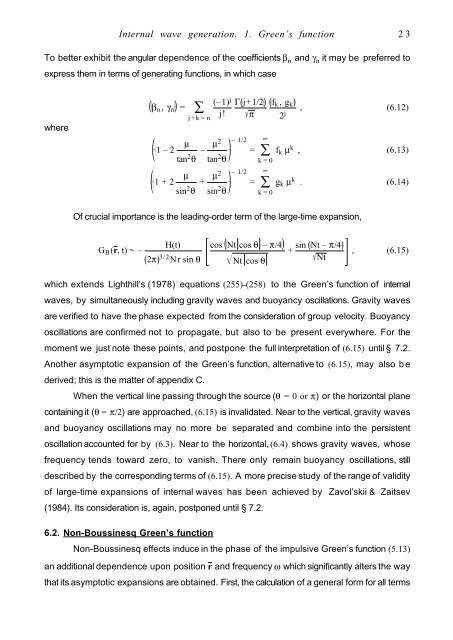Internal Wave Generation in Uniformly Stratified Fluids. 1 ... - LEGI
Internal Wave Generation in Uniformly Stratified Fluids. 1 ... - LEGI
Internal Wave Generation in Uniformly Stratified Fluids. 1 ... - LEGI
Create successful ePaper yourself
Turn your PDF publications into a flip-book with our unique Google optimized e-Paper software.
To better exhibit the angular dependence of the coefficients β n and γ n it may be preferred to<br />
express them <strong>in</strong> terms of generat<strong>in</strong>g functions, <strong>in</strong> which case<br />
where<br />
<strong>Internal</strong> wave generation. 1. Green’s function 23<br />
βn , γn =<br />
1 – 2 μ<br />
tan 2 θ<br />
1 + 2 μ<br />
s<strong>in</strong> 2 θ<br />
∑<br />
j + k = n<br />
(–1) j<br />
j!<br />
– μ2<br />
tan 2 θ<br />
+ μ2<br />
s<strong>in</strong> 2 θ<br />
Γ j+1/2<br />
π<br />
– 1/2<br />
– 1/2<br />
∞<br />
∑<br />
fk , gk<br />
2 j<br />
= fk μ k<br />
k = 0<br />
∞<br />
∑<br />
= gk μ k<br />
k = 0<br />
, (6.12)<br />
, (6.13)<br />
. (6.14)<br />
Of crucial importance is the lead<strong>in</strong>g-order term of the large-time expansion,<br />
GB(r, t) ~ –<br />
H(t)<br />
2π 3/2 Nr s<strong>in</strong> θ<br />
cos Nt cos θ – π/4<br />
Nt cos θ<br />
+ s<strong>in</strong> Nt – π/4<br />
Nt<br />
, (6.15)<br />
which extends Lighthill’s (1978) equations (255)-(258) to the Green’s function of <strong>in</strong>ternal<br />
waves, by simultaneously <strong>in</strong>clud<strong>in</strong>g gravity waves and buoyancy oscillations. Gravity waves<br />
are verified to have the phase expected from the consideration of group velocity. Buoyancy<br />
oscillations are confirmed not to propagate, but also to be present everywhere. For the<br />
moment we just note these po<strong>in</strong>ts, and postpone the full <strong>in</strong>terpretation of (6.15) until § 7.2.<br />
Another asymptotic expansion of the Green’s function, alternative to (6.15), may also be<br />
derived; this is the matter of appendix C.<br />
When the vertical l<strong>in</strong>e pass<strong>in</strong>g through the source (θ = 0 or π) or the horizontal plane<br />
conta<strong>in</strong><strong>in</strong>g it (θ = π/2) are approached, (6.15) is <strong>in</strong>validated. Near to the vertical, gravity waves<br />
and buoyancy oscillations may no more be separated and comb<strong>in</strong>e <strong>in</strong>to the persistent<br />
oscillation accounted for by (6.3). Near to the horizontal, (6.4) shows gravity waves, whose<br />
frequency tends toward zero, to vanish. There only rema<strong>in</strong> buoyancy oscillations, still<br />
described by the correspond<strong>in</strong>g terms of (6.15). A more precise study of the range of validity<br />
of large-time expansions of <strong>in</strong>ternal waves has been achieved by Zavol’skii & Zaitsev<br />
(1984). Its consideration is, aga<strong>in</strong>, postponed until § 7.2.<br />
6.2. Non-Bouss<strong>in</strong>esq Green’s function<br />
Non-Bouss<strong>in</strong>esq effects <strong>in</strong>duce <strong>in</strong> the phase of the impulsive Green’s function (5.13)<br />
an additional dependence upon position r and frequency ω which significantly alters the way<br />
that its asymptotic expansions are obta<strong>in</strong>ed. First, the calculation of a general form for all terms


